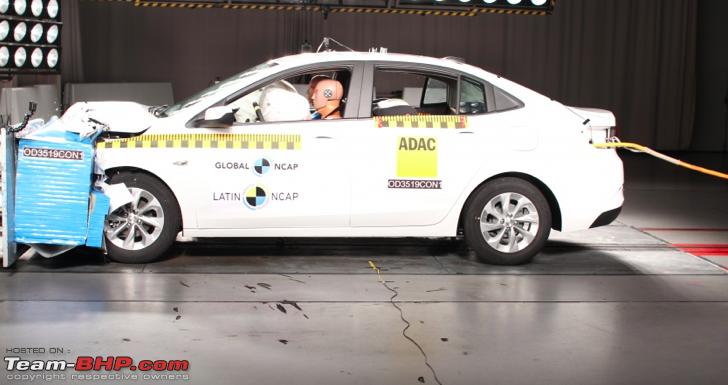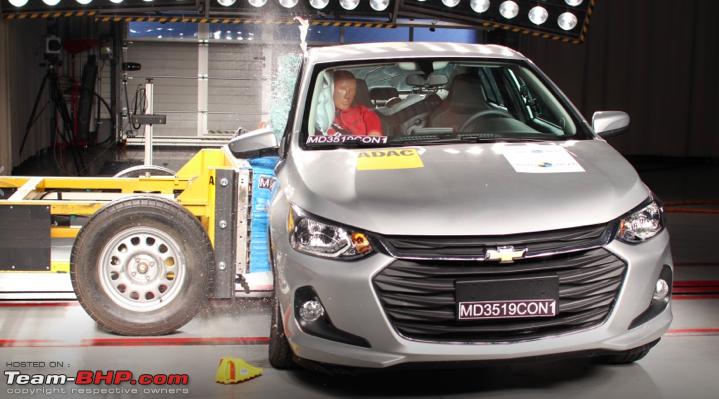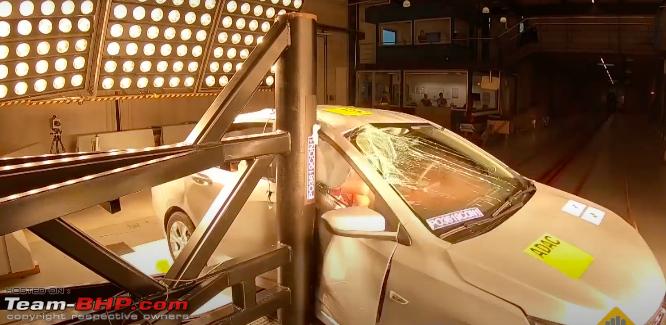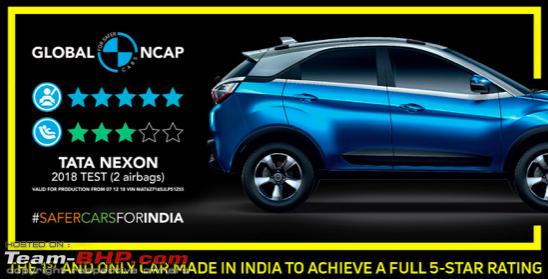| |||||||
| Search Forums |
| Advanced Search |
| Go to Page... |
 |
| Search this Thread |  26,601 views |
| | #1 |
| Senior - BHPian Join Date: Nov 2019 Location: India
Posts: 1,155
Thanked: 5,984 Times
| Understanding Global NCAP's new crash tests for India in 2022 The Global New Car Assessment Programme (Global NCAP), the FIA-funded body that evaluates the safety performance of vehicles in emerging markets, has been testing the frontal crash performance of some passenger cars on the Indian market under its Safer Cars For India project since 2014. Fifty cars have been evaluated from January 2014 to February 2022, with a number of five star results and even one Safer Choice Award. Until 2022, ratings for adult occupant protection have been assigned based on the following:
You can find out more about the old adult protection ratings at this thread. The protocol used for evaluation was Latin NCAP's 2013-2015 protocol for adults and 2010-2013 protocol for child occupants. The rating was based on a total of 17 points, out of which 16 points came from 4 body regions of the frontal crash (4+4+4+4) and 1 point was awarded for seatbelt reminders. There were balance limits for the scores to achieve a certain star rating. Five stars required a minimum score of 14 including 1 whole point for seatbelt reminders + passing ECE Regulation 95 side impact + 4-channel ABS There were star caps for having poor protection for a critical body region: zero stars if directly based on dummy readings and one star if poor after applying penalties. New evaluation for 2022Starting July of 2022, Global NCAP will introduce new protocols for assessing the safety performance of cars for the Indian market. The baseline of this protocol is 2002 Euro NCAP or 2016 Latin NCAP, however there have been several modifications to include more modern and relevant technologies in the protocols. Adult and child protection ratings will still continue to be awarded separately, but there will now be major differences in each of them. The colour of the stars used to indicate the results is now expected to be yellow instead of blue and green, which will indicate if a result is under the new protocols. The new protocols will evaluate the following:
There will be extra awards which Global NCAP is expected to announce soon. They are likely to include different types of AEB but an official announcement is awaited. The new assessment protocols can be found here: Adult Occupant Protection Child Occupant Protection Child occupant protection will include a number of changes, including using the extra data from Q-series dummies in the assessment, side impact scoring in the dynamic test, crediting i-Size approved positions, and awarding 0 points for the vehicle-based score if the car has a lapbelt in any position. This thread will only cover adult protection. Last edited by ron178 : 1st March 2022 at 19:09. |
| |  (49)
Thanks (49)
Thanks
 |
| The following 49 BHPians Thank ron178 for this useful post: | AdityaDeane, akash_v12, Ankur@VNS, AutoNoob, Bhargav7, Bibendum90949, BoneCollector, CLIX, Duckdoc, fiat_tarun, GaryTSI, GTO, Harjot37, hdman, InControl, Jeroen, K7@TN14, klgiridhar, kosjam, Leoshashi, libranof1987, lordrayden, lovetorque, Madrasin_selvan, ph03n!x, Potatopoco, prajwalmr62, PrasunBannerjee, quantobigboot, rajvardhanraje, ramnaresh_2000, RavenAvi, ruzbehxyz, saikarthik, Samfromindia, sdp1975, shancz, shashanka, skb1811, SuhairZain, Tgo, The Rationalist, theexperthand, Transmission, Viju, VinNam, volkman10, WhiteSierra, yosbert |
| |
| | #2 |
| Senior - BHPian Join Date: Nov 2019 Location: India
Posts: 1,155
Thanked: 5,984 Times
| re: Understanding Global NCAP's new crash tests for India in 2022 Frontal impactThe test configuration for frontal impact will be the same as that used by Global NCAP since 2017, which means that frontal impact results from older tests may be reused and included in new results. Tests from 2014-17 may not be reused because they use older P-series child dummies.  (Picture credit: Latin NCAP: Chevrolet Onix Plus sedan + 6 airbags 2019) There will be a few changes to the scoring in the frontal impact:
Side impactThe big change in the new protocols is the presence of a side impact in the total scoring. The side impact is scored out of 16 points like the frontal impact. You might recall that some cars (Nexon, XUV300, Punch) had to undergo a side impact to achieve a five star rating under the new protocols. That was a very basic UN Regulation intended as a pass/fail homologation test.  (Picture credit: Latin NCAP: Chevrolet Onix Plus sedan + 6 airbags 2019) The new side impact that is introduced will be different from the one you saw on those cars. In the new side impact, the barrier, speed and impact location will be the same. However, the dummy will be positioned differently and there will now be child dummies in the back seats in the recommended child seats. This is an older Euro NCAP side impact, not a UN regulation. The body regions in the side impact are: Head 4 points Chest 4 points Abdomen 4 points Pelvis 4 points The injury criteria for the head and chest are the same as those used in frontal impact (see thread). For the abdomen and pelvis, refer to the protocol. Cars will be penalised for incorrect airbag deployment (see old frontal impact), and for taking advantage of weak dummy anthropometry, i.e., using those parts of the dummy to transmit forces, that are not present in a human, and for fuel leakage. If a door opens in the side impact the score is penalised by only one point, even if it means the car would fail UN regulation, not all points for the test are lost. Seatbelt remindersIn the old protocols there was one point for seatbelt reminders, only for front occupants. There will now be two points for seatbelt reminders, one for front occupants and one for seatbelt reminders for rear occupants. The one point for front occupants is distributed as 0.5 for the driver and 0.5 for all front passengers combined, divided by the number of front passengers for each passenger. For example: Maruti Wagon R: 0.5 driver + 0.5 front passenger Fiat Multipla: 0.5 driver + 0.25 1st front passenger + 0.25 2nd front passenger Rear seatbelt reminders will only be awarded if front seatbelt reminders score the full 1 point. Rear seatbelt reminders are not divided for each occupant, but are awarded the full one point only if all rear seating positions have it. Last edited by ron178 : 1st March 2022 at 15:19. |
| |  (33)
Thanks (33)
Thanks
 |
| The following 33 BHPians Thank ron178 for this useful post: | AdityaDeane, akash_v12, Ankur@VNS, AutoNoob, Bibendum90949, CLIX, DineshKanna, fiat_tarun, GaryTSI, GTO, gururajrv, Harjot37, kosjam, Leoshashi, libranof1987, Lobogris, Meph1st0, ph03n!x, PrasunBannerjee, RavenAvi, Samfromindia, shancz, shashanka, sierrabravo98, sridhar-v, SuhairZain, Tgo, The Rationalist, theexperthand, Viju, VinNam, YD14, yosbert |
| | #3 |
| Senior - BHPian Join Date: Nov 2019 Location: India
Posts: 1,155
Thanked: 5,984 Times
| re: Understanding Global NCAP's new crash tests for India in 2022 ScoringThe score will be a sum of 16 points frontal impact + 16 points side impact + 2 points front and rear seatbelt reminders. The balance limits for the stars will be as follows: 0-4: 0 stars 4-10: 1 star 10-16: 2 stars 16-22+additional requirements: 3 stars 22-27+additional requirements: 4 stars 27-34+additional requirements: 5 stars Star capping will be applied as before: if the dummy readings indicate high risk of life-threatening injury for a critical body region in either the front or side impacts, the car will lose points for that particular impact and the car will score zero stars regardless of its score. Hence a car that scored zero stars under the old protocol will also score zero stars under the new protocol. If it is determined that only after applying penalties a body region shows poor protection (red), the star rating will be capped at one star. In case of SUVs and pickup trucks, Euro NCAP noticed that many of them could score well in the side impact just because of the height of their driver's seats, and could score adequate star ratings despite very bad frontal impact performance. Hence they introduced a penalty for all cars which Global NCAP has also carried over: if there is more than a 35% difference between the front and side impact scores, the rating is reduced by one star. Additional requirements for three, four and five starsTo score star ratings of three and above, cars will have to meet certain additional requirements. Pedestrian ProtectionPedestrian protection will be evaluated using the UN GTR9 or UN 127 pedestrian impactor tests: adult and child headforms and lower legform. The pedestrian protection must be fit as standard as a requirement for three, four and five stars. The car must pass the relevant UN regulation. Electronic Stability ControlESC will be evaluated using the UN GTR8 sine-dwell test with a steering robot to ensure repeatable results independent of the driver. The ESC must meet the following fitment requirements for different star ratings: 3 stars: In 2022 and 2023 there must be optional ESC on at least one variant. For 2024 and 2025 the requirements are identical to the requirements for five stars. 4 stars: Requirements are identical to the requirements for five stars. 5 stars: ESC must be fitted as standard to the best-selling variant of the car, or the total sales volume of ESC should be equivalent to the number of units of the best-selling variant. For example, take a car with three variants, L, M, H: Let's assume L is the highest selling variant. In that case, one of the following requirements must be met: All units of variant L must be fitted with ESC, or the ESC sales volume of L+M+H in total must be equal to the total sales volume of L. In addition, the manufacturer must sign a commitment to offer the ESC as a standalone option (not bundled with anything else, like an automatic gearbox) in all variants for two years after the date of publication, after which it must be made standard equipment for that model. Failure to do this might result in a retroactive reduction of the rating. Side Head Protection Device (pole test)A side head protection device, like a curtain airbag or a combination torso-head airbag or any other head protection technology must meet a minimum sales volume and must meet performance requirements according to an old Euro NCAP pole test (v5.2).  (Picture credit: Latin NCAP: Chevrolet Onix Plus sedan + 6 airbags 2019) In the test the car should be able to prevent life-threatening injury to the head, avoid hard contact through the airbag, and avoid direct contact with the pole. All other body regions must avoid high risk of life-threatening injury (i.e. red) and there will be no penalties applied beyond dummy readings. For 3 stars: For 2022 and 2023 there is no requirement of a head protection device. For 2024 and 2025 it must be available on at least one variant and the manufacturer must present a full-scale in-house test. For 4 stars: For 2022 and 2023 a head protection device must be available on at least one variant and the manufacturer must present a full-scale in-house test. For 2024 the head protection device must be fit to at least 30% of sales volume of the car and must pass the pole test at a Global NCAP accredited test lab. For 2025 it must be fit to at least 50% of the sales volume of the car and must pass the pole test at a Global NCAP accredited test lab. For 5 stars: For 2022 the head protection device must be fit to at least 30% of sales volume of the car. For 2023 it must be fit to at least 50% of sales volume of the car and must pass the pole test at a Global NCAP accredited test lab. For 2024 it must be fit to at least 70% of sales volume of the car and must pass the pole test at a Global NCAP accredited test lab. For 2025 it must be fit to at least 90% of sales volume of the car and must pass the pole test at a Global NCAP accredited test lab. Seatbelt RemindersFor 3, 4 and 5 stars: The car must have front seatbelt reminders for all front occupants as standard which must meet specific Euro NCAP performance requirements (they ensure that the reminders are more annoying than required by Indian or UN regulation but not so annoying that the user tries to disable the system). To score seatbelt reminder points the head, neck and chest in frontal impact and all body regions in side impact must not be red or brown. Rear seatbelt reminders will be credited and could help a car achieve a higher star rating, but are not an explicit requirement for any star rating. Last edited by ron178 : 2nd March 2022 at 07:09. |
| |  (27)
Thanks (27)
Thanks
 |
| The following 27 BHPians Thank ron178 for this useful post: | AdityaDeane, akash_v12, AutoNoob, CLIX, d3mon, ferokan, fiat_tarun, GaryTSI, GTO, Harjot37, InControl, kosjam, Leoshashi, libranof1987, Lobogris, NiInJa, ph03n!x, RavenAvi, shancz, skb1811, SuhairZain, The Rationalist, theexperthand, Viju, VinNam, yesyeswe, yosbert |
| | #4 |
| Senior - BHPian Join Date: Nov 2019 Location: India
Posts: 1,155
Thanked: 5,984 Times
| re: Understanding Global NCAP's new crash tests for India in 2022 FAQsIf a car scored a certain star rating under the old protocols, how many stars would it score under the new protocols? That is impossible to say because additional tests must be conducted. A car that scored five stars earlier might not have ESC and might score two stars now. Another five star car that meets ESC fitment requirements and has good performance in head protection and pedestrian protection might retain its five star rating. There have been cases where a four star car became a zero star car just based on the injuries and high penetration of the MDB in the side impact. Is this the same Latin NCAP protocol where popular cars have been scoring zero stars? No. That is 2020 Latin NCAP protocol which is based on the scoring skeleton of 2009 Euro NCAP. This protocol is somewhat based on 2016 Latin NCAP (based on 2002 Euro NCAP) though with changes to the special requirements (some more, some less). If the rating now includes optional safety equipment, how is it fair to someone buying a basic variant? The ratings from July will not be just for the basic specified version but will be for the model as a whole. However, this creates problems. It is not possible to test every variant of a car, but sometimes there are technologies which have not yet become so affordable that manufacturers can fit them as standard without raising costs significantly. On one side, giving credit to an optional system could make a manufacturer introduce a very expensive variant with optional equipment which will help the car achieve a better rating though no one buys it. On the other hand, testing only the base variant might not be enough to inform consumers properly, because it is possible that a car with some optional equipment might actually perform better than another car that has it as standard. The compromise between the two is fitment rates, where Global NCAP will test a system only if it sells in enough volume. It is important to note as a consumer that though the star rating is valid for a model as a whole, the rating may have been influenced by optional equipment not fitted to the base variant. Hence it is also important that a consumer chooses the best equipped variant in order to gain the full safety benefits of the rating. Is it possible for a car's star rating to increase under the new protocols? It's rare but not impossible. For example, a car that previously scored a 4-star-worthy result in the frontal impact could make up for it by doing exceedingly well in the side impact (it would also need ESC, pedestrian protection, head protection etc) and score five stars. What happens to the old results, then? They remain on the website for consumer to use, especially while buying used cars. Manufacturers can advertise a result under the older protocols for four years after publication. However, it is very important that the manufacturer follows publication guidelines and makes clear the colour of the stars (hence the protocol used) and the test year. For example:  This rating is wrong. The star colours used are yellow, which might mislead consumers into thinking it's under the new protocols, and the test year is missing. In addition, there is no child occupant protection rating so consumers might think it's a combined four star rating.  This rating is correct. The star colours used are blue for adults and green for children, which indicates that it is under the old protocol. In addition, the test year is mentioned so consumers are less likely to mix the two ratings. How long will this protocol continue? This protocol will continue until December 2025, which is the time until when funding for Safer Cars For India has been renewed. Whether testing continues beyond that or not, will depend on the formation of a local Bharat NCAP by then, as well as funding agreements with the FIA Foundation. Isn't it unfair to suddenly spring this on manufacturers? OEMs have been informed of these protocols since July 2021. They have been informed for a long time that Global NCAP would follow a similar path to Latin NCAP after a few years. To calculate what the result would have been under the old protocol, can I just take the new frontal impact score and add a point for SBR? No. There are some changes in the scoring for the frontal impact which might not make this a good idea. The first five star carThe race for five stars is on again. What would the attributes of a new five star car be? A five star car would now have to perform well in all three impact tests (front+side+pole) and have a high sales volume of a side head protection device like a curtain airbag which should perform well in the pole test. It should have seatbelt reminders for at least the front occupants and could benefit from having seatbelt reminders for rear occupants. It would need to have UN-compliant ESC with a very high ESC %sales volume and available as an independent option or as standard: It would also have to pass the basic UN regulation for pedestrian protection as standard (unlike Latin NCAP where it was an extra award): Last edited by ron178 : 2nd March 2022 at 07:17. |
| |  (38)
Thanks (38)
Thanks
 |
| The following 38 BHPians Thank ron178 for this useful post: | AdityaDeane, akash_v12, Ankur@VNS, AROO7, AutoNoob, AZT, CircleOfLife, CLIX, ferokan, fiat_tarun, fluidicjoy, FlyWheel8, GTO, Harjot37, K_Drive, Leoshashi, libranof1987, Lobogris, Nature&Me, ph03n!x, Potatopoco, raksrules, RavenAvi, rjcorona, sainyamk95, Samfromindia, shancz, skb1811, SuhairZain, Tgo, The Rationalist, theexperthand, Viju, VinNam, vnabhi, YD14, yesyeswe, yosbert |
| | #5 |
| Team-BHP Support  | re: Understanding Global NCAP's new crash tests for India in 2022 Thread moved out from the Assembly Line. Thanks for sharing! |
| |  (2)
Thanks (2)
Thanks
 |
| The following 2 BHPians Thank Aditya for this useful post: | GTO, ron178 |
| | #6 |
| BHPian Join Date: Jul 2021 Location: Mumbai
Posts: 316
Thanked: 1,607 Times
| re: Understanding Global NCAP's new crash tests for India in 2022 Again they (manufacturers) will find creative ways of portraying their vehicles in the best possible light, by cherry picking the results that need to be highlighted while others which may be hidden. (After all, in marketing, not showing the complete picture is the rule of the day, whether it is correct or not, being moot.) But all said and done, some improvement will definitely happen in the industry as a whole, even if its not up to the actual standards, and that in itself, is a big win for the Indian customer... |
| |  (1)
Thanks (1)
Thanks
 |
| The following BHPian Thanks kosjam for this useful post: | sainyamk95 |
| | #7 |
| Senior - BHPian | Re: Understanding Global NCAP's new crash tests for India in 2022 Great thread as always ron178. This was a much needed update as the current GNCAP test has been going on since 2014 and was too basic, plus it has served it's purpose very well of creating awareness of safety and pushed OEM's and authorities to progress towards safer cars. I am glad GNCAP has defined the installation requirements for the additional technologies like ESP & side airbags, which will ensure it is not restricted to one very expensive model that will make up <5% of the model sales. Also ensuring the ESC is offered as a standalone option is also a great move to ensure such technologies actually reach the end customer. I anticipate the Bharat NCAP to be formed on very similar lines and we might have one sooner than expected, considering OEM's might support the NCAP route rather than a mandatory route which will otherwise be forced by the government. (e.g., the 6 airbags rule) |
| |  (7)
Thanks (7)
Thanks
 |
| The following 7 BHPians Thank fiat_tarun for this useful post: | gauravanekar, jithin23, PrasunBannerjee, ron178, Sen, sri_tesla, youngknight |
| | #8 |
| Senior - BHPian Join Date: Sep 2019 Location: Pune
Posts: 2,487
Thanked: 7,462 Times
| Re: Understanding Global NCAP's new crash tests for India in 2022 I think that GNCAP has done its job which basically was to create awareness on how the cars rank on safety under certain test conditions. I think the Parliament must really take up Bharat NCAP as an independent regulatory body asap so that it can be a good benchmark. We should not need to have a GNCAP kind of a watchdog ideally, ever. |
| |  (1)
Thanks (1)
Thanks
 |
| The following BHPian Thanks fhdowntheline for this useful post: | Lobogris |
| | #9 |
| BANNED Join Date: Apr 2015 Location: Kochi
Posts: 924
Thanked: 7,279 Times
| Re: Understanding Global NCAP's new crash tests for India in 2022 So TATA will need to equip it's cars with more airbags and ESC as standard to get good ratings. XUV 700 will mostly retain it's 5* reading. It's sad that the government is not doing much to make BNCAP or whatever they are going to name it a reality. |
| |  (2)
Thanks (2)
Thanks
 |
| The following 2 BHPians Thank The Rationalist for this useful post: | Lobogris, ron178 |
| | #10 |
| Newbie Join Date: Feb 2022 Location: Bangalore
Posts: 3
Thanked: 10 Times
| Re: Understanding Global NCAP's new crash tests for India in 2022 They should include a rollover test, it is a more common form of accident esp when tall SUVs are selling more. I had seen a video where they had put weight on the top left edge of cars to check if they deform, up to 3 car weights. Here is another video I found: As for BNCAP, India can have tie up with Euro NCAP, South American NCAP etc to share crash test results mutually. There are a few common tests and criteria. So that manufacturers dont have to wreck too many cars in multiple countries. |
| |  (2)
Thanks (2)
Thanks
 |
| The following 2 BHPians Thank vintherace for this useful post: | Rohan265, ron178 |
| | #11 | ||
| Senior - BHPian Join Date: Nov 2019 Location: India
Posts: 1,155
Thanked: 5,984 Times
| Re: Understanding Global NCAP's new crash tests for India in 2022 Quote:
Secondly, OEMs' production control might be vastly different for cars made in or for India. Weaker spot welds, cold-stamped members, you name it. Another thing is that Bharat NCAP would need to develop tests specifically based on data collected for road crashes in India. The Global NCAP frontal offset crash was developed by Euro NCAP, and while data shows it covers at least 20% of car-to-car crashes in India, there are a lot of crash scenarios common in India that are far less common in Europe. Quote:
Far too basic; it was developed for the very purpose of creating a market for vehicle safety in the first place and nothing more. Using it as an overall safety rating is not a good idea, though frontal impact is an important scenario nevertheless. The big problem is that affordable cars today have technologies like side airbags and ESC, and the last thing one would want is for consumers to think those technologies are useless just because they're not needed for a good star rating. Under the new protocols that will not be as big a problem. The old protocols were there to make consumers hungry for better rated cars so manufacturers would follow. Once that is achieved they can increase the requirements at a very good pace and most manufacturers will follow and will find affordable ways to meet them. Last edited by ron178 : 7th March 2022 at 15:27. | ||
| |  (1)
Thanks (1)
Thanks
 |
| The following BHPian Thanks ron178 for this useful post: | fiat_tarun |
| |
| | #12 | ||||
| Distinguished - BHPian  | Re: Understanding Global NCAP's new crash tests for India in 2022 Renault Group CEO calls for rethink on NCAP crash test rules. Renault Group CEO Luca de Meo has called for a debate on whether Euro NCAP safety tests are still fit for purpose. Quote:
Quote:
Quote:
Quote:
| ||||
| |  (2)
Thanks (2)
Thanks
 |
| The following 2 BHPians Thank volkman10 for this useful post: | shancz, V.Narayan |
| | #13 | |
| Senior - BHPian Join Date: Nov 2019 Location: India
Posts: 1,155
Thanked: 5,984 Times
| Re: Understanding Global NCAP's new crash tests for India in 2022 Global NCAP addendum to new protocols: zero stars for presence of side-facing rear seats. Is the Scorpio Classic being retested? Quote:
| |
| |  ()
Thanks ()
Thanks
 |
| | #14 | |
| BHPian | Re: Understanding Global NCAP's new crash tests for India in 2022 Quote:
“I want a system of common sense - perhaps these days the rarest commodity of all. If they proposed a system to stop drink-drivers starting a car, I would install it tomorrow. If they wanted to use autonomous technology to restrict speeds to the limits, I’d agree. Let’s look at the problems - speed, distraction, physical condition issues - with solutions.” I thought, that's so easy to say. Common sense is indeed rare and would always say that safety should not be compromised at the expense of people's lives. Common sense also says that one does not need to digress from the fact that safety here means life is not lost due to any structural defect in the car. Drunk driving or anything else for that matter do have respective channels to deal separately. Focus here is on safety aspects I believe. If we never had any such ratings, how many manufacturers would have bothered to really put out safe cars! Some respect and discipline for law, regulations has to be there. | |
| |  ()
Thanks ()
Thanks
 |
| | #15 |
| Senior - BHPian Join Date: Feb 2020 Location: Hyderabad
Posts: 8,293
Thanked: 43,844 Times
| Re: Understanding Global NCAP's new crash tests for India in 2022 |
| |  (4)
Thanks (4)
Thanks
 |
| The following 4 BHPians Thank Venkatesh for this useful post: | fiat_tarun, ron178, sdp1975, shancz |
 |



